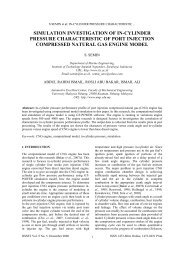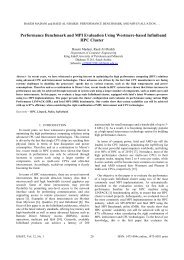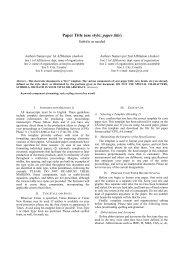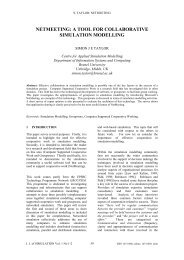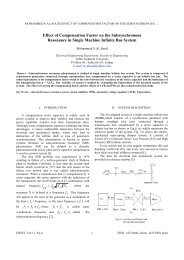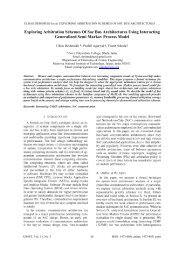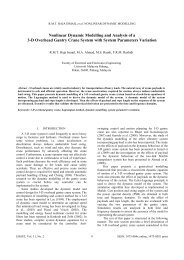TRANSIENT ANALYSIS OF THE BMAP/PH/1 QUEUE - Irisa
TRANSIENT ANALYSIS OF THE BMAP/PH/1 QUEUE - Irisa
TRANSIENT ANALYSIS OF THE BMAP/PH/1 QUEUE - Irisa
You also want an ePaper? Increase the reach of your titles
YUMPU automatically turns print PDFs into web optimized ePapers that Google loves.
L. M. LE NY, B. SERICOLA: <strong>TRANSIENT</strong> <strong>ANALYSIS</strong><strong>TRANSIENT</strong> <strong>ANALYSIS</strong> <strong>OF</strong> <strong>THE</strong> <strong>BMAP</strong>/<strong>PH</strong>/1<strong>QUEUE</strong>L. M. LE NY and B. SERICOLAIRISA-INRIACampus universitaire de Beaulieu35042 Rennes cedex, FranceEmail : {Louis-Marie.LeNy, Bruno.Sericola}@irisa.fr,Abstract: We derive in this paper the transient queue length and the busy period distributions of a single serverqueue with phase-type (<strong>PH</strong>) service times and a batch Markovian arrival process (<strong>BMAP</strong>). These distributionsare obtained by the uniformization technique which gives simple recurrence relations. The main advantage ofthis technique is that it leads to stable algorithms for which the precision of the result can be given in advance.Keywords: <strong>BMAP</strong>, busy period, transient queue length, uniformization.1 INTRODUCTIONWe consider a single server queue with infinite waitingroom for which the arrival process is a BatchMarkovian Arrival Process (<strong>BMAP</strong>) and the servicetimes are given by a Phase-type (<strong>PH</strong>) distribution.The <strong>BMAP</strong> has received considerable interest duringthe last few years. It was first introduced by [Neuts,1979] as the versatile Markovian point process. Itgeneralizes the Markovian Arrival Process (MAP) introducedby [Lucantoni et al, 1990]. A tutorial onthe <strong>BMAP</strong>/G/1 queue is presented in [Lucantoni,1993] and the transient behavior of this queue is analyzedin [Lucantoni et al, 1994] and extended in [Lucantoni,1998] using numerical inversions of Laplacetransforms and generating functions.More recently, in [Hofmann, 2001] a generalizationof the <strong>BMAP</strong>/G/1 queue where the arrival processis allowed to depend on the state level of thequeue was analyzed. The distribution of the stationaryqueue length at service completion timesand at arbitrary time is given using matrix inversions.In [Dudin, 2001] and [Machihara, 1999], the<strong>BMAP</strong>/SM/1 queue with negative arrivals and servicetimes depending on the arrival process is proposedfor modeling some realistic situations like cancellationsof calls.We consider here the <strong>BMAP</strong>/<strong>PH</strong>/1 queue and wefocus on the transient queue length and busy perioddistributions. The main advantage with respectto the <strong>BMAP</strong>/G/1 queue is that the behavior of the<strong>BMAP</strong>/<strong>PH</strong>/1 queue is governed by a homogeneousMarkov process and so it can be analyzed avoidingthe use of Laplace transforms and generating functionsinversion algorithms which can lead to severenumerical errors and overflow problems. Moreoverthe set of <strong>PH</strong> probability distributions is dense inthe set of probability distributions on (0, ∞), see [Asmussen,1987] for instance. The transient behaviorof queues, see [Duffield et al, 1998], is of great importancefor the design and control of new communicationsnetworks, above all when the interarrivalsand service times are not exponential. In [Takine,2000] an alternative recursion formula to computethe stationary <strong>BMAP</strong>/G/1 queue length distributionat a random point in time is shown to be identicalto the stationary distribution of the corresponding<strong>BMAP</strong>/G/1 queue with multiple vacations and exhaustiveservices.For the analysis of the <strong>BMAP</strong>/<strong>PH</strong>/1 queue, we considerthe uniformization technique that can be foundin [Ross, 1983]. Its main advantage is that it leadsto the analysis of a discrete time Markov chain forwhich all the required quantities to evaluate are givenby recurrence relations involving only additions andmultiplications of non negative numbers bounded byone and thus leading to stable algorithms. Moreover,the precision of the results can be given in advance.The remainder of the paper is organized as follows.In the next section we review some definitions andproperties of the <strong>BMAP</strong> that can also be found withmore detail in [Lucantoni, 1993] and we describethe Markov process governing the behavior of the<strong>BMAP</strong>/<strong>PH</strong>/1 queue. In Section 3 and 4 we deriveI.J.of SIMULATION Vol.3 No. 3-4 4 ISSN 1473-804x online, 1473-8031 print
L. M. LE NY, B. SERICOLA: <strong>TRANSIENT</strong> <strong>ANALYSIS</strong>the recurrence relations used for the computation ofthe transient queue length distribution and the busyperiod distribution respectively. We illustrate ourmethod through numerical examples in Section 5.2 <strong>THE</strong> <strong>BMAP</strong>/<strong>PH</strong>/1 <strong>QUEUE</strong>2.1 The Batch Markovian ArrivalProcessThe <strong>BMAP</strong> is a two dimensional Markov process{A(t),J(t)} on the state space {(i, j)|i ≥ 0, 1 ≤j ≤ m} with infinitesimal generator given by⎡⎢⎣D 0 D 1 D 2 D 3 . . .D 0 D 1 D 2 . . .D 0 D 1 . . .D 0 . . .. . .where D k , k ≥ 0, are m × m matrices such thatmatrix D 0 has negative diagonal elements and nonnegative off diagonal elements; matrices D k , k ≥ 1,have non negative elements and matrix D, definedby∞∑D = D k ,k=0is an irreducible infinitesimal generator. We also assumethat D ≠ D 0 , which ensures that arrivals willoccur.The variable A(t) counts the number of arrivals during[0,t) and the variable J(t) represents the phase ofthe arrival process. Let π be the stationary probabilityof the Markov process with infinitesimal generatorD, i.e. π satisfiesπD =0andπ1 =1,where 1 is a column vector of 1’s; its dimension beingspecified by the context. Then the component π j isthe stationary probability that the arrival process isin state j. The stationary arrival rate of the processis then∞∑λ = π kD k 1. (1)k=1More detail and results concerning this process canbe found in [Lucantoni, 1993] for instance.2.2 The Queueing ModelWe consider a single server queue with a <strong>BMAP</strong> specifiedby the sequence {D k , k ≥ 0}. Let the servicetimes be i.i.d. and independent of the arrival process.The service times have a phase-type (<strong>PH</strong>) distribution[Neuts, 1981] with l + 1 states given by its⎤⎥⎦initial probability distribution (β,β l+1 ) and infinitesimalgenerator [ ]T T0.0 0For the sake of simplicity, we assume that β l+1 =0.Note that β is a non negative l dimensional row vectorsatisfying β1 =1. MatrixT is a l×l non singularmatrix and T 0 is a l dimensional column vector satisfyingT 0 = −T 1. The mean service time µ is thengiven byµ = −1βT −1 1 . (2)The process describing the behaviour of the<strong>BMAP</strong>/<strong>PH</strong>/1 queue is then a Markov process X(t),over the state spacewhereand, for n ≥ 1,S =∞⋃C n ,n=0C 0 = {(0,j) | 1 ≤ j ≤ m}C n = {(n, j, k) | 1 ≤ j ≤ m, 1 ≤ k ≤ l}.The couple (0,j) represents the state for which thereare no customer in the queue and the arrival processis in phase j. For n ≥ 1,thetriple(n, j, k)represents the state for which there are n customersin the queue, and the arrival process is in phase jand the customer being served is in phase k. Withthis description of the state space, the infinitesimalgenerator of the process is given bywhere⎡A =⎢⎣A 0,0 A 0,1 A 0,2 A 0,3 . . .A 1,0 A 1 A 2 A 3 . . .A 0 A 1 A 2 . . .A 0 A 1 . . .A 0 . . .. . .A 0,0 = D 0 ,A 0,j = D j ⊗ β for j ≥ 1,⎤⎥⎦A 1,0 = I m ⊗ T 0 ,A 1 =(D 0 ⊗ I l )+(I m ⊗ T ),A j = D j−1 ⊗ I l for j ≥ 2andA 0 = I m ⊗ (T 0 β),where the matrix I r denotes the r×r identity matrixand ⊗ denotes the classical Kronecker product.Let us define ν =sup{−A(u, u), u∈ S}. It is easyto verify thatν = max{−D 0 (j, j), j=1,...,m}+ max{−T (k, k), k=1,...,l}.I.J.of SIMULATION Vol.3 No. 3-4 5 ISSN 1473-804x online, 1473-8031 print
L. M. LE NY, B. SERICOLA: <strong>TRANSIENT</strong> <strong>ANALYSIS</strong>Using now the uniformization technique [Ross, 1983],we denote by Z(n) the uniformized Markov chain associatedto X(t), with Z(0) = X(0). Its transitionprobability matrix P is given by P = I + A/ν, whereI denotes the infinite identity matrix. Matrix P isa stochastic matrix and has the same structure asmatrix A withP 0,0 = I m + A 0,0 /ν, P 0,j = A 0,j /ν for j ≥ 1,P 1,0 = A 1,0 /ν, P 1 = I ml + A 1 /ν,P j = A j /ν for j ≥ 2andP 0 = A 0 /ν.For i ≥ 1, we define the subsetsi⋃B i = C n .n=0For every i ≥ 0, B i represents the states of S correspondingto at most i customers in the queue.3 <strong>THE</strong> <strong>QUEUE</strong> LENGTHWe denote by α the row vector containing the initialprobability distribution of the Markov process X(t)and by 1 Bi , i ≥ 0, the infinite column vector withthe first |B i | entries equal to 1 and the others equalto 0.We define Y (t) as the number of customers in thequeue at time t. The distribution of Y (t) isthengiven byPr(Y (t) ≤ i) = Pr(X(t) ∈ B i )= αe At 1 Bi=∞∑e −νt(νt)n Pr(Z(n) ∈ B i ),n!n=0where Pr(Z(n) ∈ B i )isgivenbyPr(Z(n) ∈ B i )=αP n 1 Bi .We now derive recurrence relations for the computationof Pr(Z(n) ∈ B i ).For every n ≥ 0andi ≥ 0 we define the infinitecolumn vector U (n)B iasU (n)B i= P n 1 Bi .The infinite column vector U (n)B ican be decomposedinto subvectors U (n)(n)h,i, h ≥ 0. The vector U 0,i is ofdimension m and for h ≥ 1, U (n)h,iis of dimension ml.With this notation, we have for h ≥ 1, 1 ≤ j ≤ mand 1 ≤ k ≤ l,(U (n)0,i =U (n)h,i=)Pr(Z(n) ∈ B i |Z(0) = (0,j))(Pr(Z(n) ∈ B i |Z(0) = (h, j, k))j)j,k .It follows that for h ≥ i + n +1,wehaveU (n)h,i=0.Indeed, if h ≥ i + n + 1, it is not feasible to haveat most i customers in the queue in n transitions,starting with h customers in the queue at time 0.For n =0,wehaveU (0)B i= 1 Bi and for n ≥ 1, writingU (n)B i= PU (n−1)B i, we get the following recurrencerelations, for 2 ≤ r ≤ i + n.U (n)0,i =i+n−1∑h=0P 0,h U (n−1)h,i(3)i+n−1∑U (n)1,i = P 1,0 U (n−1)0,i + P 0,h U (n−1)h,i(4)U (n)r,i =i+n−1∑h=r−1h=1P h−r+1 U (n−1)h,i. (5)We now decompose the initial probability distributionα as α =(α h ) h≥0 where the subvector α h correspondsto the initial probability distribution whenthere are exactly h customers in queue, that is, forh ≥ 1, 1 ≤ j ≤ m and 1 ≤ k ≤ l,()α 0 = Pr(Z(0) = (0,j))j()α h = Pr(Z(0) = (h, j, k))Using this notation we getPr(Z(n) ∈ B i )=∞∑h=0α h U (n)h,i∑= n+ih=0j,k .α h U (n)h,i . (6)Let ε be the desired error tolerance for the computationof Pr(Y (t) ≤ i), we define the truncation stepN as⎧⎫∣⎨ ∣∣∣∣∣N =min⎩ n ∈ INn ∑j=0e −νt(νt)jj!⎬≥ 1 − ε⎭ . (7)The distribution of Y (t) can then be written asPr(Y (t) ≤ i) =N∑n=0where e(N) verifiese(N) =≤e −νt(νt)nn!∞∑n=N+1∞∑n=N+1= 1−≤ ε.N∑n=0e −νt(νt)nn!e −νt(νt)nn!e −νt(νt)nn!Pr(Z(n) ∈ B i )+e(N),Pr(Z(n) ∈ B i )I.J.of SIMULATION Vol.3 No. 3-4 6 ISSN 1473-804x online, 1473-8031 print
L. M. LE NY, B. SERICOLA: <strong>TRANSIENT</strong> <strong>ANALYSIS</strong>Remark 1: The computation of integer N can bemade without any numerical problems even for largevalues of νt by using the method described in [Bowermanet al, 1990].Remark 2: The truncation level N is in fact afunction of t, sayN(t) and it can be easily shownthat for a fixed value of ε, N(t) is an increasingfunction of t. It follows that if we want to computePr(Y (t) ≤ i) for M distinct values of t denotedby t 1 < ··· t)=P 1 P 2 P 3 . . .P 0 P 1 P 2 . . .P 0 P 1 . . .P 0 . . .. . .. .∞∑n=0⎤.⎥⎦e −νt(νt)n βQ n 1.n!Defining the infinite column vector U (n) as U (n) =Q n 1, we get the recurrence relation U (n) = QU (n−1)with U (0) = 1.Let V (n) be defined by V (n) = 1 − U (n) . We thengetV (n) = V (1) + QV (n−1) , (9)with V (0) =0andV (1) = 1 − Q1.We decompose the infinite column vector V (n) intosubvectors V (n)i , i ≥ 1ofdimensionml. For i ≥ 1,vector V (n)i can be interpreted using the uniformizedMarkov chain Z(n) as()V (n)i = Pr(NV ≤ n|Z(0) = (i, j, k)),1≤j≤m,1≤k≤lwhere NV denotes the number of states visited duringthe busy period. It follows immediately that fori ≥ n +1, we have V (n)i = 0. Indeed, the numberof states visited during a busy period cannot be lessthan or equal to n if the initial number of customersI.J.of SIMULATION Vol.3 No. 3-4 7 ISSN 1473-804x online, 1473-8031 print
L. M. LE NY, B. SERICOLA: <strong>TRANSIENT</strong> <strong>ANALYSIS</strong>in the queue is greater than or equal to n +1. Thevectors V (n) thus have a finite number of non zeroentries; that is why it is preferable to use thesevectors instead of the U (n) .Using relation (9), we obtain the following recurrencerelation, using the fact that P 1,0 1 = P 0 1,n−1∑V (n)1 = P 0 1 + P h V (n−1)h(10)V (n)i=n−1∑h=i−1h=1P h−i+1 V (n−1)hfor 2 ≤ i ≤ n(11)The matrix P being a substochastic matrix the sequenceof vectors U (n) decreases to 0 when n tends toinfinity, for ρ t) =where==e 1 (N ′ )=∞∑n=0∑N ′n=0∑N ′n=0N ′−e −νt(νt)n βU (n)n!e −νt(νt)n βU (n) + e 1 (N ′ )n!e −νt(νt)nn!∑n=0∞∑n=N ′ +1e −νt(νt)n βV (n) + e 1 (N ′ ),n!e −νt(νt)n βU (n) .n!If N ′ = N then we have, by definition of N,e 1 (N ′ ) =≤∞∑n=N+1∞∑n=N+1= 1−≤ ε.N∑n=0e −νt(νt)n βU (n)n!e −νt(νt)nn!e −νt(νt)nn!If N ′ = N 1 then we have, by definition of N 1 ,e 1 (N ′ ) =≤∞∑n=N 1+1ε≤ ε.∞∑n=N 1+1e −νt(νt)n βU (n)n!e −νt(νt)nn!We thus have e 1 (N ′ ) ≤ ε. Wewillseeinthenextsection that the truncation step N ′ can be significantlyless than N. Note that both Remarks 1 and 2of the previous section also apply here for the computationof Pr(BP > t). So suppose that we need tocompute the busy period distribution for M distinctvalues of t, denoted by t 1 < ··· t) − G(t) =e 1 (N ′ (t M )) ≤ e 1 (N ′ (t)) ≤ ε.Below we give the algorithm which we developed tocompute the busy period distribution.input : t 1 < ···
L. M. LE NY, B. SERICOLA: <strong>TRANSIENT</strong> <strong>ANALYSIS</strong>rate from state 1 to state 0 is denoted by µ 1 . Thearrival rate from state 0 (resp. 1) is denoted by λ 0(resp. λ 1 ). The auxiliary phase in the overall <strong>BMAP</strong>can be characterized by the number of MMPPs thatare in state 1. This number is initialy supposed tobe equal to 0, that is, all the MMPPs are initialy instate 0. The service times distribution is assumed tobe Erlang of order l (denoted by E l , l ≥ 1) with unitmean time so that the time units are in mean servicetimes.It follows that the overall <strong>BMAP</strong> is given by the matricesD 0 and D 1 (D k =0fork ≥ 2) of dimensionm × m where m = h + 1. The non-zero entries ofmatrices D 0 and D 1 are, for 0 ≤ i ≤ h,and,D 1 (i, i) = (h − i)λ 0 + iλ 1D 0 (i, i) = −[(h − i)(λ 0 + µ 0 )+i(λ 1 + µ 1 )]D 0 (i, i +1) = (h − i)µ 0 for 0 ≤ i ≤ h − 1D 0 (i, i − 1) = iµ 1 for 1 ≤ i ≤ hThe arrival rate of the overall <strong>BMAP</strong> is then[]µ 1 µ 0λ = h λ 0 + λ 1 .µ 0 + µ 1 µ 0 + µ 1r=1The mean service times being equal to 1, the trafficintensity ρ is given by ρ = λ. In all figures we assumethat λ 0 =0.01, λ 1 =0.04, µ 0 =0.04, µ 1 =0.01 andthe error tolerance is ε =0.0001.Figure 1 shows the complementary cumulative distributionfunction of the transient queue length for the∑20MMPP r /E 4 /1 model, which gives a traffic intensityρ =0.68. The initial queue length is i ′ = 20.It can be noted that for values of t greater than100 the curves coincide with the curve obtained fort = 100 and so the steady state seems to be reached.Figure 2 shows the complementary emptiness functionfor the MMPP r /E 4 /1 model which gives∑20ar=1traffic intensity ρ =0.68, for different initial queuelength. Note that the steady state value of this function(ρ =0.68) is reached for t = 200.Figure 3 shows the complementary emptiness functionfor the MMPP r /E l /1 model which gives∑20ar=1traffic intensity ρ =0.68, for different values of thenumber l of phases in the Erlang service distribution.The initial queue length is i ′ = 20. It is interestingto note that for t greater than 80 there are no moredifferences between the curves and so it seems thatthe number of service phases does not have a greatinfluence on the emptiness function. Here the steadystate value of this function (ρ =0.68) is reached fort = 100.Figures 4 and 5 show the complementary emptinessh∑function for the MMPP r /E 4 /1 model whichr=1r=1gives a traffic intensity ρ = h × 0.034, for differentvalues of the number h of MMPPs. The initial queuelength is i ′ =20inFigure4andi ′ = 0 in Figure 5.Note that for h =29wegetρ =0.986, for h =30weget ρ =1.02, and for h =40wegetρ =1.36. Notealso the convergence to the steady state value ρ1.Figure 6 shows the complementary cumulative distributionfunction of the busy period for the∑20MMPP r /E 4 /1 model which gives a traffic intensityρ =0.68, for different values of the initialqueue length. Note that the rate of convergence to0 depends on the initial queue length. Concerningthe truncation steps, for t = 200, we have N = 1125and the following values of N ′ depending on the initialqueue length. These results show that the useof the truncation step N ′ can signicantly reduce thecomputation time of the algorithm.i ′ 1 5 10 20 ≥ 30N ′ 86 269 506 878 1125r=1Figure 7 shows the complementary cumulative distributionfunction of the busy period for the∑20MMPP r /E l /1 model which gives a traffic intensityρ =0.68, for different values of the number l ofphases in the Erlang service distribution. The initialqueue length is i ′ = 20. As for Figure 3, it is interestingto note that there are not many differencesbetween the curves and so it seems that the numberof service phases does not have a great influence onthe busy period distribution. In this case, for t = 200and l =6,wehaveN = 1549 and N ′ = 1172.Figure 8 shows the complementary cumulative distributionfunction of the busy period for theh∑MMPP r /E 4 /1 model which gives a traffic inten-r=1sity ρ = h × 0.034, for different values of the numberh of MMPPs. The initial queue length is i ′ = 20. Asfor Figure 5, we have ρ1forh ≥ 30.I.J.of SIMULATION Vol.3 No. 3-4 9 ISSN 1473-804x online, 1473-8031 print
L. M. LE NY, B. SERICOLA: <strong>TRANSIENT</strong> <strong>ANALYSIS</strong>10.80.60.4t=1t=10t=20t=30t=40t=50t=1000.200 5 10 15 20 25i∑20Figure 1: Pr(Y (t) >i), as a function of i and t in the MMPP r /E 4 /1 queue with initial queue length i ′ = 20.r=110.80.60.40.2i’=0i’=5i’=10i’=20i’=30i’=40i’=50i’=10000 50 100 150 200t∑20Figure 2: Pr(Y (t) > 0), as a function of t and the initial queue length i ′ in the MMPP r /E 4 /1 queue.r=1I.J.of SIMULATION Vol.3 No. 3-4 10 ISSN 1473-804x online, 1473-8031 print
L. M. LE NY, B. SERICOLA: <strong>TRANSIENT</strong> <strong>ANALYSIS</strong>10.950.90.850.80.750.7l=1l=2l=3l=4l=100.650.60 20 40 60 80 100t∑20Figure 3: Pr(Y (t) > 0), as a function of t for different values of the number l of phases in the MMPP r /E l /1queue with initial queue length i ′ = 20.r=110.80.60.4h=1h=10h=20h=29h=300.200 20 40 60 80 100tFigure 4: Pr(Y (t) > 0), as a function of t for different values of the number h of MMPPs in theh∑MMPP r /E 4 /1 queue with initial queue length i ′ = 20.r=1I.J.of SIMULATION Vol.3 No. 3-4 11 ISSN 1473-804x online, 1473-8031 print
L. M. LE NY, B. SERICOLA: <strong>TRANSIENT</strong> <strong>ANALYSIS</strong>10.80.60.4h=1h=10h=20h=29h=30h=400.200 20 40 60 80 100tFigure 5: Pr(Y (t) > 0), as a function of t for different values of the number h of MMPPs in theh∑MMPP r /E 4 /1 queue with initial queue length i ′ =0.r=110.80.6i’=1i’=5i’=10i’=20i’=30i’=40i’=50i’=600.40.200 50 100 150 200tFigure 6: Pr(BP > t), as a function of t and the initial queue length i ′ in the20∑r=1MMPP r /E 4 /1 queue.I.J.of SIMULATION Vol.3 No. 3-4 12 ISSN 1473-804x online, 1473-8031 print
L. M. LE NY, B. SERICOLA: <strong>TRANSIENT</strong> <strong>ANALYSIS</strong>10.80.60.4l=1l=2l=3l=4l=5l=60.200 20 40 60 80 100 120 140t∑20Figure 7: Pr(BP > t), as a function of t for different values of the number l of phases in the MMPP r /E l /1queue with initial queue length i ′ = 20.r=110.80.60.40.2h=1h=10h=20h=29h=30h=4000 20 40 60 80 100tFigure 8: Pr(BP > t), as a function of t for different values of the number h of MMPPs in thequeue with initial queue length i ′ = 20.h∑MMPP r /E 4 /1r=1I.J.of SIMULATION Vol.3 No. 3-4 13 ISSN 1473-804x online, 1473-8031 print
L. M. LE NY, B. SERICOLA: <strong>TRANSIENT</strong> <strong>ANALYSIS</strong>REFERENCESAsmussen S. 1987, Applied Probability and Queues.John Wiley and Sons.Bowerman P. N., Nolty R. G. and Scheuer E. M.1990, “Calculation of the poisson cumulative distributionfunction”. IEEE Transactions on Reliability,Vol. 39. Pp:158–161.Dudin A. N., Karolik A. V. 2001, “<strong>BMAP</strong>/SM/1queue with Markovian input of disasters and noninstantaneousrecovery”. Performance Evaluation,Vol. 45. Pp:19–32.Duffield N. G., Whitt W. 1998, “A source trafficmodel and its transient analysis for network control”.Stochastic Models, Vol. 14. Pp:51–78.Hofmann J. 2001, “The <strong>BMAP</strong>/G/1 queue withLevel-Dependent Arrivals - An Overview”. T-elecommunication Systems , Vol. 16. Pp:347–360.Lucantoni D. M., Meier-Hellstern K. S. and NeutsM. F. 1990, “A single server queue with server vacationsand a class of non-renewal arrival processes”.Adv. Appl. Prob., Vol. 22. Pp:676–705.Lucantoni D. M. 1993, “The <strong>BMAP</strong>/G/1 queue: Atutorial”. In L. Donatiello and R. Nelson, editors,Performance Evaluation of Computer and CommunicationsSystems. Lectures Notes in Computer Science729, Springer Verlag, Pp:330–358.Lucantoni D. M., Choudhury G. L. and Whitt W.1994, “The transient <strong>BMAP</strong>/G/1 queue”. StochasticModels, Vol. 10. Pp:145–182.Lucantoni D. 1998, “Further Transient Analysis ofthe <strong>BMAP</strong>/G/1 queue”. Stochastic Models, Vol. 14.Pp:461–478.Machihara F. 1999, “A <strong>BMAP</strong>/SM/1 queue withservice times depending on the arrival process”.Queueing Systems - Theory and Application ,Vol.33. Pp:277–292.Neuts M. F. 1979, “A versatile Markovian pointprocess”. J. Appl. Prob., Vol. 16. Pp:764–779.Neuts M. F. 1981, Matrix-Geometric Solutions inStochastic Models: An Algorithmic Approach. Baltimore:The Johns Hopkins University Press.Ross S. M. 1983, Stochastic Processes. John Wileyand Sons.Takine T. 2000, “A new recursion for the queuelength distribution in the stationary <strong>BMAP</strong>/G/1queue”. Stochastic Models, Vol. 16. Pp:335–341.BIOGRA<strong>PH</strong>YLOUIS-MARIE LE NY is an AssociateProfessor in Applied Mathematicsat Rennes 1 university(France). He is also part of theARMOR (Networks architecturesand Modeling) group at IRISA laboratory.His research interests include queueing networks analysis and performanceevaluation of Internet Protocols.BRUNO SERICOLA received thePh.D. degree in computer sciencefrom the University of Rennes I in1988. He has been with INRIA (InstitutNational de Recherche en Informatiqueet Automatique, a publicresearch French laboratory) since 1989. His main research activity is in computerand communication systems performance evaluation,dependability and performability analysis offault-tolerant architectures and applied stochasticprocesses.I.J.of SIMULATION Vol.3 No. 3-4 14 ISSN 1473-804x online, 1473-8031 print



